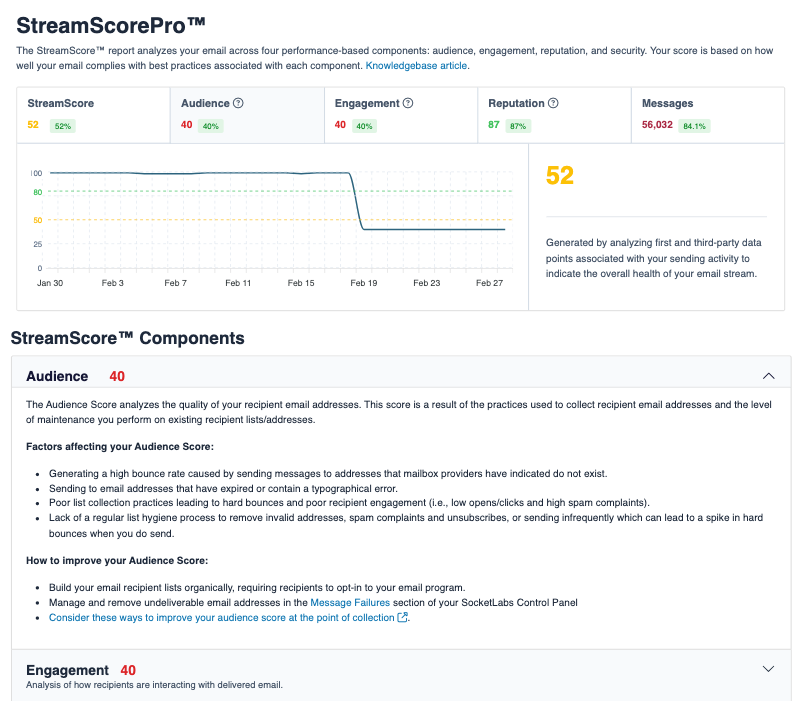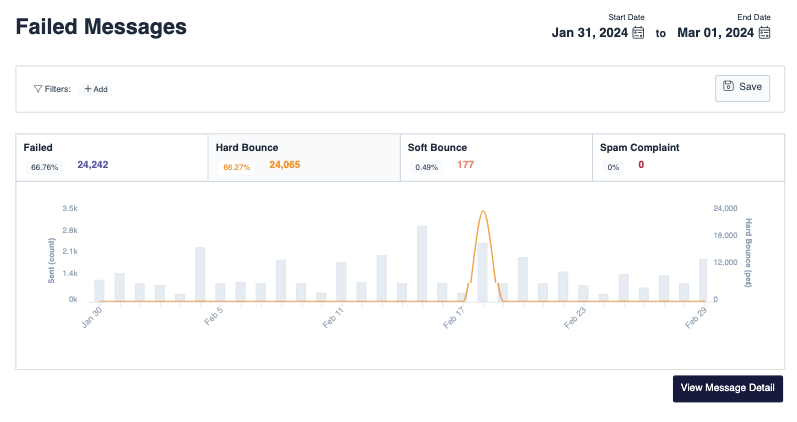
No pressure or anything, but your email program is a very public performance, and the joy and rapture of your audience is entirely in your hands. The content is your song and dance, and the inbox is your stage. Can you feel the heat of the lights?!
Seriously, though, email really isn’t even a “thing” without someone to read it, much like a performance isn’t really a performance without someone to watch. Whether direct mail, personal email or promotional email from business to consumer, email is designed to reach someone, somewhere.
That’s why your email audience is such a major part of your sender reputation, and it’s also why we use “audience” as one of our four StreamScore components.
Let’s explore what we can consider an audience and how it affects your email performance.
What Is An “Audience?”
A somewhat renowned English-nerd named Merriam-Webster defines an audience as “the people giving or likely to give attention to something.”
For our purposes, your audience is the group of people you are sending email to. You likely already know this, but we need to set the stage for you, our…audience…
What Is Audience Health?
Let’s say you have an email list with 100 addresses on it.
In a perfect world, all 100 addresses are valid, given with explicit consent, and will open and click on your email when they receive it. This audience is incredible. You are Hamilton on Broadway to them. This audience gives your sender reputation rave reviews because they love you. “ENCORE,” they cry, “ENCORE!”
But we know this world is far from perfect.
In a more realistic scenario, your audience of 100 includes some folks who were dragged there by their spouse, maybe someone who isn’t super into musicals but wants to step out of their comfort zone, and several are no-shows because they simply changed their minds about going. It is what it is. Maybe only 65 of those people enthusiastically bought tickets.
This mosaic of personalities is your audience health. The more reliable an address is, the more value it brings to your email program, and by extension, the better it reflects on your sender reputation.
Mailbox providers (MBPs) are Broadway. They want their users to feel entertained at all times. Give them ACTION!
Happy Audience Members
You want an audience full of people who bought tickets to your show. Accurate, live addresses are all you want on your distribution lists.
You won’t really know good from bad until you send to each address at least once, but the overall goal is to have an audience with nothing but people who freely gave you a real email address and are eager (or at least are expecting) to receive your mail.
The value of a good audience member can increase and decrease over time. For instance, if someone stops interacting with your email but you continue to send to them, and they consistently either ignore or delete your email without reading them, they’re not as good anymore.
Conversely, if someone gives you a real address but is tepid in their response to you, maybe opening a few emails here and there, but then they start opening every message you send because you’re suddenly speaking their language…they’re a much better audience member than before.
The more happy audience members on your list, the better your sender reputation. They give you a reputable name. No one would rush to see Hamilton if the audience was full of people who say “meh” when they walk out. Speaking of…
“Meh” Audience Members
They’re in the room. They’re sitting there with their eyes open. They’re not giving you a standing ovation, but they aren’t hissing every time you step on stage.
You want to keep a keen eye on the middling members of your audience because they’re also your wild-card folks. The next email they see could be the final straw spurring them to pluck the tomatoes they’re keeping under their seat to let them loose, but it could also be the one inspiring them to stand up and shout “bravo” via a click.
So, if you notice a group of recipients who haven’t engaged positively nor negatively, make sure you monitor their behavior over the next few sends to give yourself the best chance of treating them properly. You might want to segment them into a small group so you can try out different, potentially more appealing messaging, or you might want to proactively sunset them to minimize risks.
What risks? Well, let’s look at the last category of audience members.
Unhappy Audience Members
Think of a movie that was an all-time flop. Art is subjective, so you can fill in your own blank…unless you want to say Titanic, in which case you need to pick something else because you’re wrong.
If you are sending to people who are reacting to your mail the same way you reacted to that flop, you’re sending to a bad audience.
Here are a few examples of sub-par email audience members:
- Fake, invalid, or otherwise unreachable addresses
- Addresses added to a list without their consent
- Addresses without any detectable engagement for an extended period
- Individuals with consistent negative engagement, like delete-without-reading
- Recipients who move mail to spam or outright complain
You want as few troublemaking audience members on your list as possible. If your group of 100 people has more than one or two hecklers in the audience, you start to run the risk of MBPs treating your email as though it’s not all it’s cracked up to be. Worse, they might believe you shouldn’t have a show at all, and begin rejecting or placing your email into spam folders.
To be clear, though, this isn’t really the fault of the people on your lists. Sure, maybe some people asked for tickets to your show with a fake address just so they could get the discount you offered in exchange for their information. People abandon their mailboxes and get new addresses elsewhere.
It’s on you to make sure your audience is as happy as possible and remains that way well beyond opening night. If not, your bad reputation could get you tossed off Broadway onto…whatever is the opposite of Broadway. Narrowroad.
Managing your Audience
While I’ve never been to Broadway because I’m one of those “musicals ain’t my bag” gals, I’m certain you can’t just toss audience members out of the theatre when they make a face you don’t like. Luckily, because I’d be thrown out left and right.
The good news is that IS exactly how you can manage your email audience! You don’t even have to wait for negative behavior from them; you can unilaterally toss people who look ready to cause a ruckus.
If you’re a SocketLabs customer, you have a StreamScore where you’ll be able to see your audience quality in no uncertain terms: It’s green and positive, it’s yellow and risky, or it’s red and you have an issue.
Take a look at the below audience score. 
You can see where quality really dropped off. Perhaps there was a new list introduced, and that list was purchased so most of the addresses were invalid or otherwise garbage. See the impact? Audience ain’t nothing to play with.

For senders without SocketLabs, you’ll need to rely on your knowledge of best practices and the metrics you get from your email service provider’s reporting tools, or MBP-provided info at places like Google Postmaster Tools. A big indicator of an audience problem is a high number of hard bounces.
We recommend periodically cleaning your lists, too. Look at the data available to you, find dormant addresses, like those without any recent engagement. You can also do a re-engagement campaign to see if anyone wants to re-commit to being in your audience or at least give them an invitation to leave without hard feelings. Courtesy can go a long way.
End Scene
At the end of the day, you want an audience full of people who want to be there and enjoy what it is you’re offering. You want an audience who will keep coming back for more. In email, you have the luxury of curating your audience to give you the best reviews and feedback possible, signaling to MBPs that you’re a hot ticket and they should treat you as such.
We’re always happy to help you shine a spotlight on your sender performance. Combine our reporting platform with our expert stage direction (both in-platform and via customer support), and you’ve got the makings of a hit performance on your hands. Take a look at SocketLabs Spotlight today!







